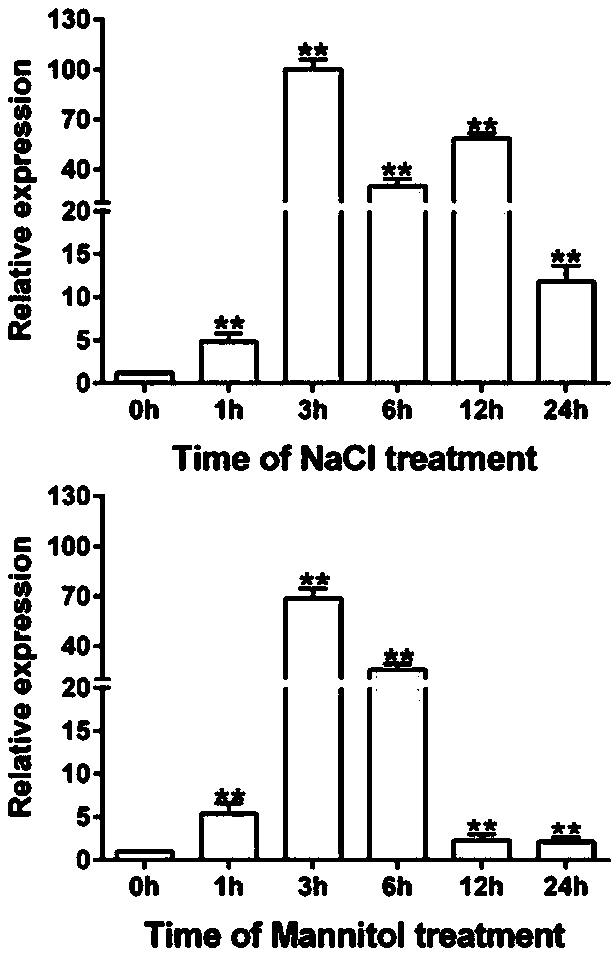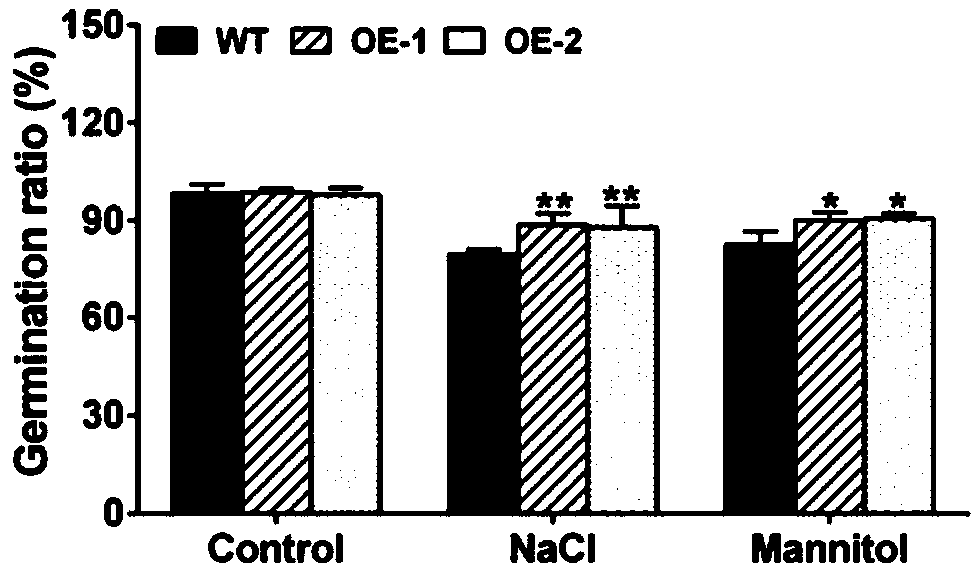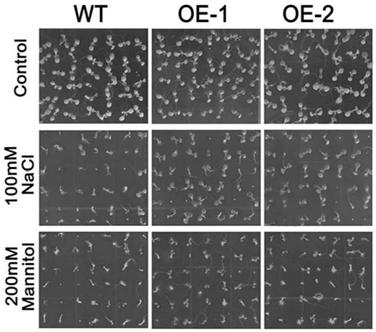Corn 3-glyceraldehyde phosphate dehydrogenase ZmGPDH1 and application of coding gene of corn 3- glyceraldehyde phosphate dehydrogenase ZmGPDH1 to regulation and control over plant stress tolerance
A technology of plant stress tolerance and transgenic plants, applied in application, plant products, genetic engineering, etc., can solve the problems of few research reports
- Summary
- Abstract
- Description
- Claims
- Application Information
AI Technical Summary
Problems solved by technology
Method used
Image
Examples
Embodiment 1
[0074] Expression pattern of ZmGPDH1 gene in maize root under embodiment 1, salt and osmotic stress
[0075] 1. Processing of plant samples
[0076] 200mM NaCl and 400mM mannitol were used to treat the three-leaf and one-heart period corn (Maize He 344 inbred line) seedlings, and the roots were sampled at different time points (0, 1, 3, 6, 12 and 24h), and liquid nitrogen quick-frozen , stored at -80°C for RNA extraction.
[0077] 2. RNA extraction and reverse transcription
[0078] Total RNA was extracted using TRIzol reagent (Invitrogen). cDNA was obtained by reverse transcription using ReverTra Ace qPCR RT MasterMix with gDNA Remover (TOYOBO).
[0079] 3. Real-time quantitative PCR
[0080] Real-time quantitative PCR was performed using the Bio-Rad Chromo4real-time PCR system. Maize ZmGAPDH (XM_020551757) and ZmACTIN (XM_008656735.2) were used as internal references to standardize data. Primer sequences are shown in Table 1. Relative expression level using 2 -△△CT m...
Embodiment 2
[0086] Example 2, the acquisition of ZmGPDH1 transgenic Arabidopsis and its stress tolerance analysis
[0087] 1. Obtaining and identification of ZmGPDH1 transgenic Arabidopsis
[0088]1. Taking maize root cDNA as a template, using ZmGPDH1-GFP-F and ZmGPDH1-GFP-R primers for PCR amplification to obtain PCR amplification products. The primer sequences are as follows (the underlined sequence is the enzyme recognition site):
[0089] ZmGPDH1-GFP-F: 5'-GC TCTAGA ATGGTTGGGAGCGTGCACGTC-3';
[0090] ZmGPDH1-GFP-R:5'-ACGC GTC GAC TGGTTTTTCCAAGGAGAGACG-3'.
[0091] 2. Carry out double digestion and ligation of the pBI121-GFP vector and the PCR amplification product obtained in step 1 with restriction endonucleases XbaI and SalI to obtain the recombinant plasmid 35S:ZmGPDH1-GFP. and validated by sequencing.
[0092] Sequencing results show that the recombinant vector 35S:ZmGPDH1-GFP replaces the DNA fragment between the XbaI and SalI restriction sites of the pBI121-GFP vector wi...
PUM
 Login to View More
Login to View More Abstract
Description
Claims
Application Information
 Login to View More
Login to View More - R&D
- Intellectual Property
- Life Sciences
- Materials
- Tech Scout
- Unparalleled Data Quality
- Higher Quality Content
- 60% Fewer Hallucinations
Browse by: Latest US Patents, China's latest patents, Technical Efficacy Thesaurus, Application Domain, Technology Topic, Popular Technical Reports.
© 2025 PatSnap. All rights reserved.Legal|Privacy policy|Modern Slavery Act Transparency Statement|Sitemap|About US| Contact US: help@patsnap.com



